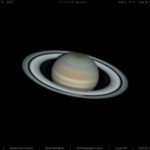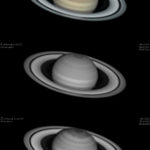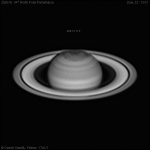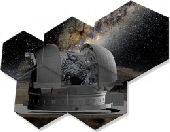[RAW single best frames]
ITALIAN language (for ENGLISH please read more below)
Il mese di giugno, ormai quasi giunto al termine, ci ha regalato belle serate semi estive, la maggior parte delle quali caratterizzate da forti differenze di temperatura tra giorno e notte che si traducevano in una cattiva stabilità atmosferica subito dopo le primissime ore della notte.
La sera del 22 giugno scorso, la visibilità in alta risoluzione dei dettagli planetari è stata leggermente migliore, potendomi permettere una serie di riprese a miglior risoluzione rispetto a tutte le precedenti serate avute quest’anno.
Le immagini qui allegate, scaturiscono da un set di 18 filmati eseguiti in autorun con la mia filterwheel in luce Rossa, Verde, Blu ed Infrarossa (R-G-B-IR) dalle 20:20 di Tempo Universale (U.T.) alle 22:25 circa e dove è chiaramente evidente, nella banda Infrarossa a 715nm, la perturbazione che attualmente si muove a 64° di latitudine nord, meglio evidenziata nella gif animata consistente di tre set di 6 immagini derotate (precedentemente sommate da filmati di 1350 frames), dove la perturbazione appare molto articolata a questa lunghezza d’onda della luce.
L’immagine RGB è data da un totale di 10800 frames sommati, composta da 12 migliori rossi, 9 verdi e 9 blu stacked frames.
L’immagine in luce R (la seconda dall’alto) a 610nm è composta da 4320 frames totali in 12 stacked images mentre l’immagine in luce Infrarossa (IR) è composta da un totale di 2040 migliori frames in 6 stacked images sommate e derotate; si tratta dell’arco temporale centrale durante tutta la sessione di ripresa, dove la perturbazione è maggiormente visibile.
Il filtro Infrarosso usato, è un vecchio Schott RG-715 nm a banda larga. Questo mi ha dato maggiore luce a quella lunghezza d’onda e una piccola marcia in più.
Grazie per l’attenzione e, come sempre…. ad maiora !! 😉
Dettagli tecnici:
Celestron C14 Starbright ad F/24 – Baader-Zeiss barlow 2X – Filtri RGB Baader e IR Schott RG-715 – Camera PGR Grasshopper3 (23S6M-C) – Ruota portafiltri Atik EFW2 – Seeing 6/10 per il canale Rosso ed Infrarosso.
ENGLISH:
Hello to all,
Here my last Saturn images finally in fair seeing conditions… It’s a set of autorunned 18 RGB-IR captured films, from about 20:20 UT to 22:25UT, where in IR-715nm light is prominent the 64°N perturbation, best shown in animated gif consists of three sets of 6 stacked derotate images. The disturbance seems very jagged at this light wavelength.
The RGB is a 10800 total stacked frames, 12 Red, 9 Green and 9 Blue best stacked sets of images. The R (610nm) light is from 12 best stacked frames (4320 totally) and the IR (715nm) light is from 6 central best stacked frames (2040 totally), where the polar perturbation is best visible.
To better highlight the movement and shape of the disturbance, I set up an animated gif consists of all 18 IR films, derotated into three groups of 6 stacked best images, where the disturbance is very prominent in this wavelength of light.
The IR filter is an old Schott RG-715 longpass band.
Thanks for you attention and… ad maiora semper ! 😉
Technical details:
Celestron C14 Starbright @ F/24 – Baader-Zeiss barlow 2X – Baader RGB filters and Schott RG-715 IR filter – PGR Grasshopper3 (23S6M-C) camera – Atik EFW2 filterwheel – Seeing 6/10 for Red and Infrared lights.
Carmelo “Mel” Zannelli
Palermo – Sicily (ITALY)




